Review and Critique of Operations Management at Next PLC
VerifiedAdded on 2023/06/08
|17
|5080
|497
Report
AI Summary
This report provides a comprehensive review and critique of operations management principles within Next PLC. It begins with an introduction to Next PLC, followed by an explanation differentiating operation and operations management. The report analyzes the implementation of operations management principles, particularly focusing on lean production, and assesses how well Next PLC meets its organizational requirements through its operations management. It discusses continuous improvement as a philosophy, describes lean principles, and proposes a continuous improvement plan with justified recommendations for improvement. The analysis covers work standardization, planning, and direction, and it incorporates lean methodologies like the Kanban system and Lean Six Sigma to visually manage workflows, eliminate waste, and improve output quality. The report concludes by emphasizing the importance of continuous improvement plans, such as Kaizen and Total Quality Management, to launch high-quality products and establish long-term stakeholder relationships.
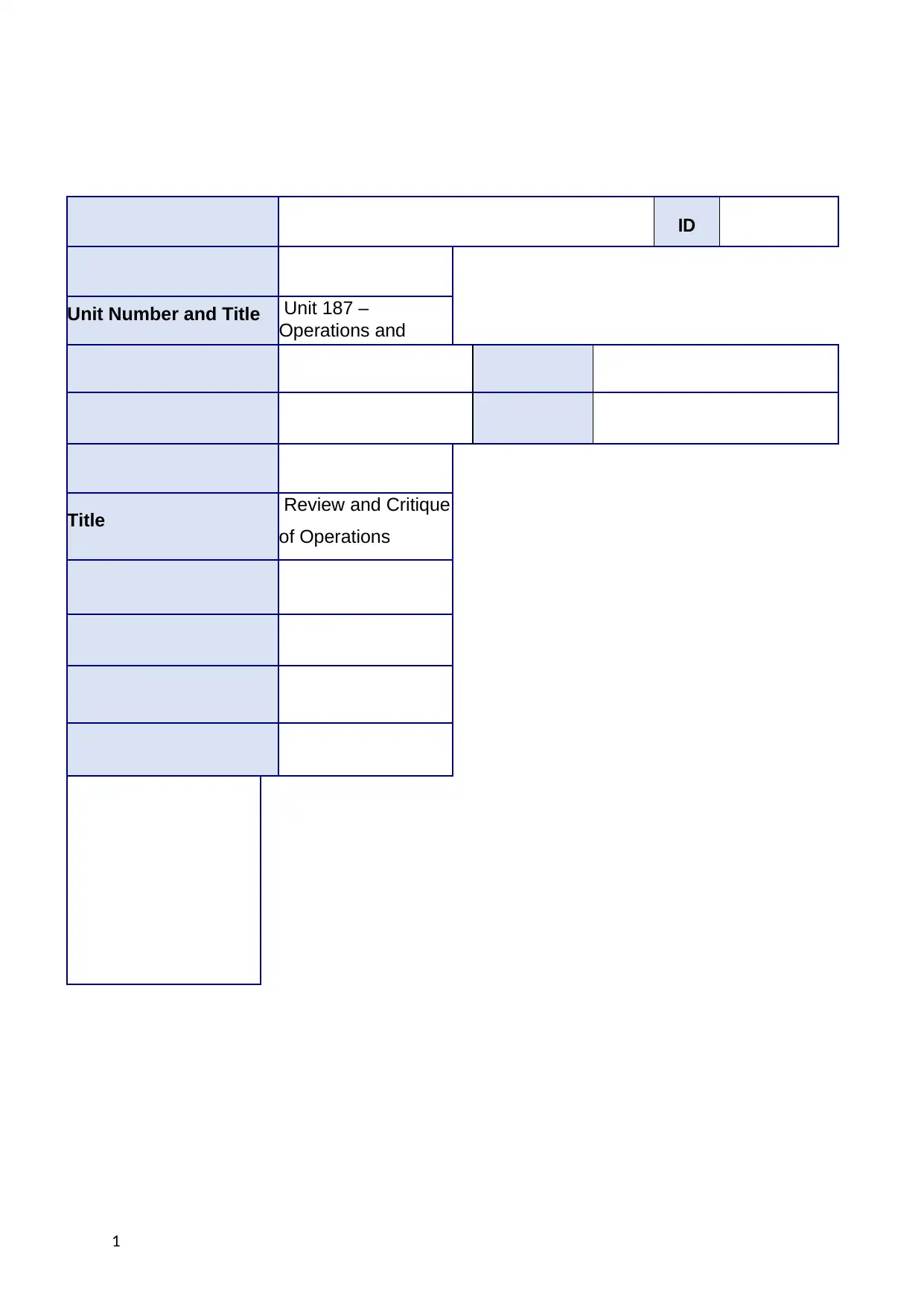
ID
Unit Number and Title Unit 187 –
Operations and
Project Management
Title Review and Critique
of Operations
Management (Part
1
Unit Number and Title Unit 187 –
Operations and
Project Management
Title Review and Critique
of Operations
Management (Part
1
Paraphrase This Document
Need a fresh take? Get an instant paraphrase of this document with our AI Paraphraser
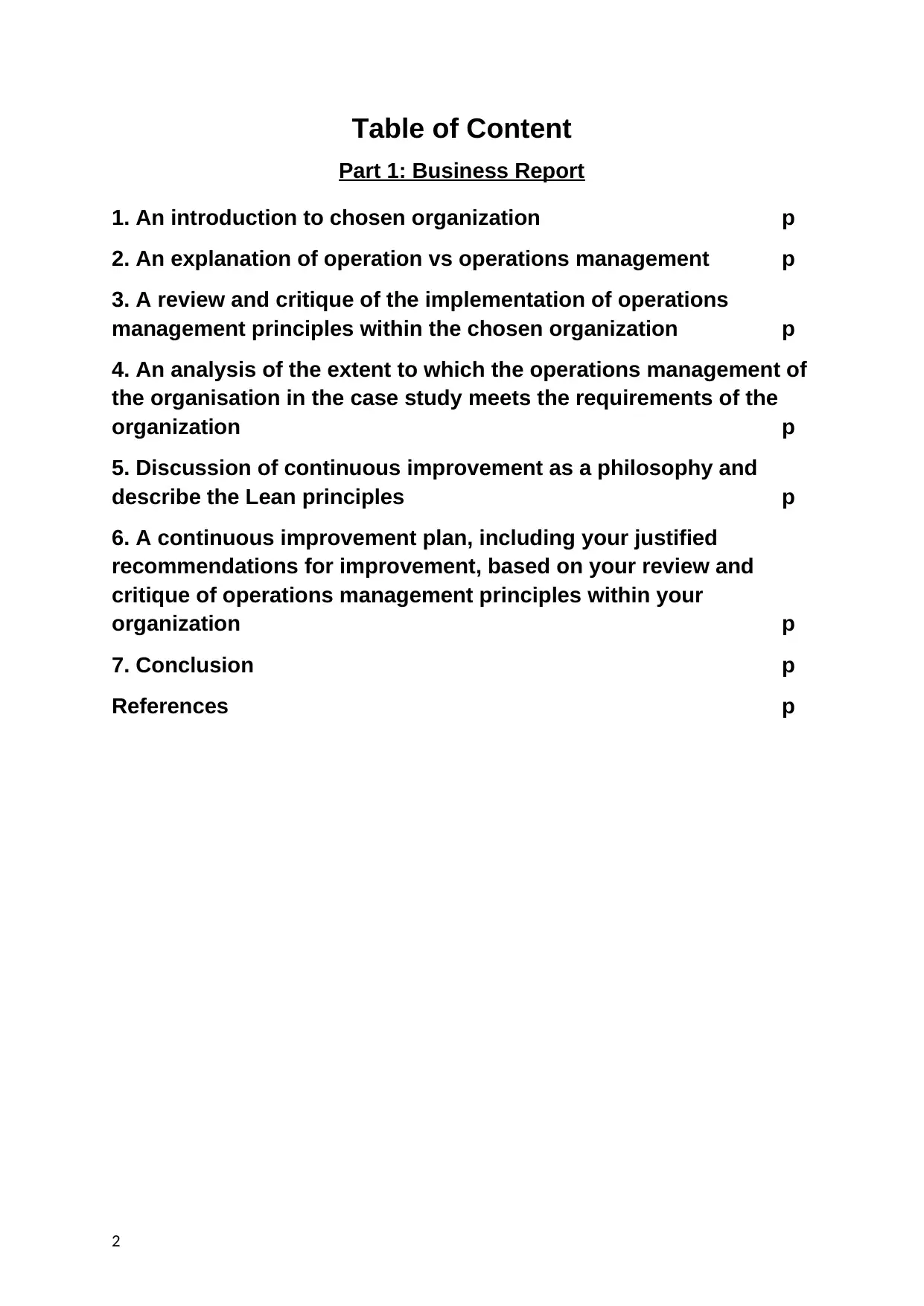
Table of Content
Part 1: Business Report
1. An introduction to chosen organization p
2. An explanation of operation vs operations management p
3. A review and critique of the implementation of operations
management principles within the chosen organization p
4. An analysis of the extent to which the operations management of
the organisation in the case study meets the requirements of the
organization p
5. Discussion of continuous improvement as a philosophy and
describe the Lean principles p
6. A continuous improvement plan, including your justified
recommendations for improvement, based on your review and
critique of operations management principles within your
organization p
7. Conclusion p
References p
2
Part 1: Business Report
1. An introduction to chosen organization p
2. An explanation of operation vs operations management p
3. A review and critique of the implementation of operations
management principles within the chosen organization p
4. An analysis of the extent to which the operations management of
the organisation in the case study meets the requirements of the
organization p
5. Discussion of continuous improvement as a philosophy and
describe the Lean principles p
6. A continuous improvement plan, including your justified
recommendations for improvement, based on your review and
critique of operations management principles within your
organization p
7. Conclusion p
References p
2
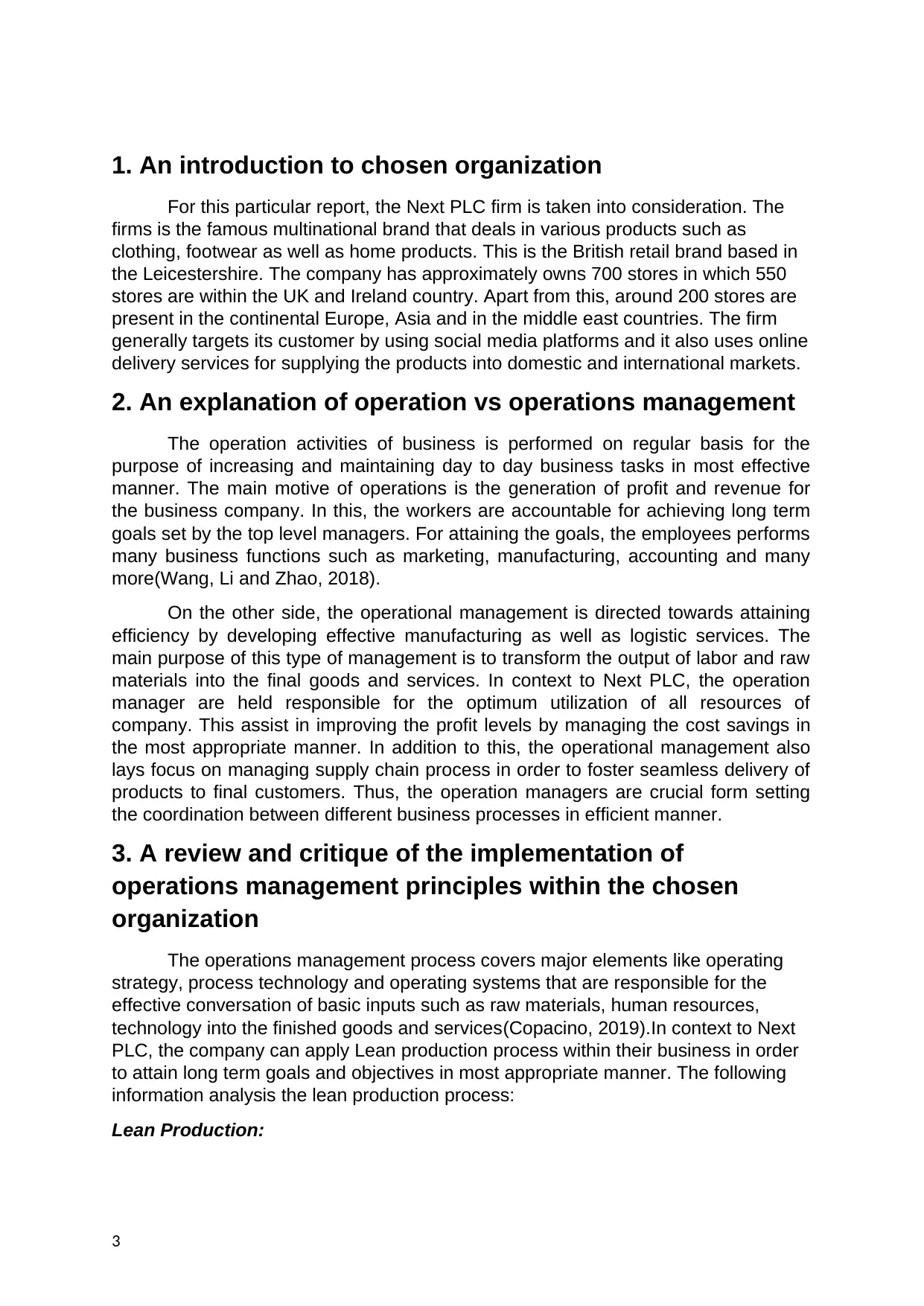
1. An introduction to chosen organization
For this particular report, the Next PLC firm is taken into consideration. The
firms is the famous multinational brand that deals in various products such as
clothing, footwear as well as home products. This is the British retail brand based in
the Leicestershire. The company has approximately owns 700 stores in which 550
stores are within the UK and Ireland country. Apart from this, around 200 stores are
present in the continental Europe, Asia and in the middle east countries. The firm
generally targets its customer by using social media platforms and it also uses online
delivery services for supplying the products into domestic and international markets.
2. An explanation of operation vs operations management
The operation activities of business is performed on regular basis for the
purpose of increasing and maintaining day to day business tasks in most effective
manner. The main motive of operations is the generation of profit and revenue for
the business company. In this, the workers are accountable for achieving long term
goals set by the top level managers. For attaining the goals, the employees performs
many business functions such as marketing, manufacturing, accounting and many
more(Wang, Li and Zhao, 2018).
On the other side, the operational management is directed towards attaining
efficiency by developing effective manufacturing as well as logistic services. The
main purpose of this type of management is to transform the output of labor and raw
materials into the final goods and services. In context to Next PLC, the operation
manager are held responsible for the optimum utilization of all resources of
company. This assist in improving the profit levels by managing the cost savings in
the most appropriate manner. In addition to this, the operational management also
lays focus on managing supply chain process in order to foster seamless delivery of
products to final customers. Thus, the operation managers are crucial form setting
the coordination between different business processes in efficient manner.
3. A review and critique of the implementation of
operations management principles within the chosen
organization
The operations management process covers major elements like operating
strategy, process technology and operating systems that are responsible for the
effective conversation of basic inputs such as raw materials, human resources,
technology into the finished goods and services(Copacino, 2019).In context to Next
PLC, the company can apply Lean production process within their business in order
to attain long term goals and objectives in most appropriate manner. The following
information analysis the lean production process:
Lean Production:
3
For this particular report, the Next PLC firm is taken into consideration. The
firms is the famous multinational brand that deals in various products such as
clothing, footwear as well as home products. This is the British retail brand based in
the Leicestershire. The company has approximately owns 700 stores in which 550
stores are within the UK and Ireland country. Apart from this, around 200 stores are
present in the continental Europe, Asia and in the middle east countries. The firm
generally targets its customer by using social media platforms and it also uses online
delivery services for supplying the products into domestic and international markets.
2. An explanation of operation vs operations management
The operation activities of business is performed on regular basis for the
purpose of increasing and maintaining day to day business tasks in most effective
manner. The main motive of operations is the generation of profit and revenue for
the business company. In this, the workers are accountable for achieving long term
goals set by the top level managers. For attaining the goals, the employees performs
many business functions such as marketing, manufacturing, accounting and many
more(Wang, Li and Zhao, 2018).
On the other side, the operational management is directed towards attaining
efficiency by developing effective manufacturing as well as logistic services. The
main purpose of this type of management is to transform the output of labor and raw
materials into the final goods and services. In context to Next PLC, the operation
manager are held responsible for the optimum utilization of all resources of
company. This assist in improving the profit levels by managing the cost savings in
the most appropriate manner. In addition to this, the operational management also
lays focus on managing supply chain process in order to foster seamless delivery of
products to final customers. Thus, the operation managers are crucial form setting
the coordination between different business processes in efficient manner.
3. A review and critique of the implementation of
operations management principles within the chosen
organization
The operations management process covers major elements like operating
strategy, process technology and operating systems that are responsible for the
effective conversation of basic inputs such as raw materials, human resources,
technology into the finished goods and services(Copacino, 2019).In context to Next
PLC, the company can apply Lean production process within their business in order
to attain long term goals and objectives in most appropriate manner. The following
information analysis the lean production process:
Lean Production:
3
⊘ This is a preview!⊘
Do you want full access?
Subscribe today to unlock all pages.

Trusted by 1+ million students worldwide
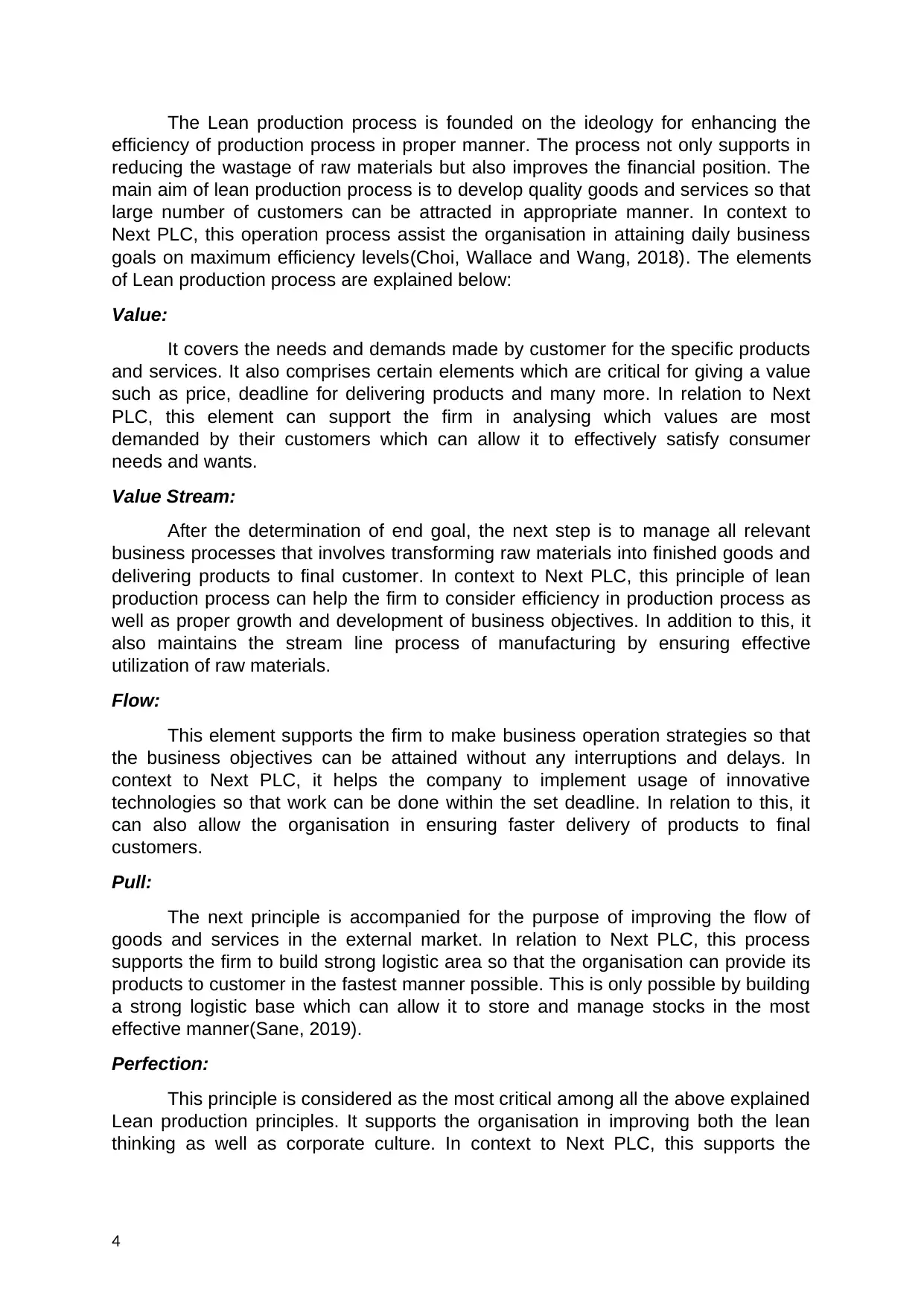
The Lean production process is founded on the ideology for enhancing the
efficiency of production process in proper manner. The process not only supports in
reducing the wastage of raw materials but also improves the financial position. The
main aim of lean production process is to develop quality goods and services so that
large number of customers can be attracted in appropriate manner. In context to
Next PLC, this operation process assist the organisation in attaining daily business
goals on maximum efficiency levels(Choi, Wallace and Wang, 2018). The elements
of Lean production process are explained below:
Value:
It covers the needs and demands made by customer for the specific products
and services. It also comprises certain elements which are critical for giving a value
such as price, deadline for delivering products and many more. In relation to Next
PLC, this element can support the firm in analysing which values are most
demanded by their customers which can allow it to effectively satisfy consumer
needs and wants.
Value Stream:
After the determination of end goal, the next step is to manage all relevant
business processes that involves transforming raw materials into finished goods and
delivering products to final customer. In context to Next PLC, this principle of lean
production process can help the firm to consider efficiency in production process as
well as proper growth and development of business objectives. In addition to this, it
also maintains the stream line process of manufacturing by ensuring effective
utilization of raw materials.
Flow:
This element supports the firm to make business operation strategies so that
the business objectives can be attained without any interruptions and delays. In
context to Next PLC, it helps the company to implement usage of innovative
technologies so that work can be done within the set deadline. In relation to this, it
can also allow the organisation in ensuring faster delivery of products to final
customers.
Pull:
The next principle is accompanied for the purpose of improving the flow of
goods and services in the external market. In relation to Next PLC, this process
supports the firm to build strong logistic area so that the organisation can provide its
products to customer in the fastest manner possible. This is only possible by building
a strong logistic base which can allow it to store and manage stocks in the most
effective manner(Sane, 2019).
Perfection:
This principle is considered as the most critical among all the above explained
Lean production principles. It supports the organisation in improving both the lean
thinking as well as corporate culture. In context to Next PLC, this supports the
4
efficiency of production process in proper manner. The process not only supports in
reducing the wastage of raw materials but also improves the financial position. The
main aim of lean production process is to develop quality goods and services so that
large number of customers can be attracted in appropriate manner. In context to
Next PLC, this operation process assist the organisation in attaining daily business
goals on maximum efficiency levels(Choi, Wallace and Wang, 2018). The elements
of Lean production process are explained below:
Value:
It covers the needs and demands made by customer for the specific products
and services. It also comprises certain elements which are critical for giving a value
such as price, deadline for delivering products and many more. In relation to Next
PLC, this element can support the firm in analysing which values are most
demanded by their customers which can allow it to effectively satisfy consumer
needs and wants.
Value Stream:
After the determination of end goal, the next step is to manage all relevant
business processes that involves transforming raw materials into finished goods and
delivering products to final customer. In context to Next PLC, this principle of lean
production process can help the firm to consider efficiency in production process as
well as proper growth and development of business objectives. In addition to this, it
also maintains the stream line process of manufacturing by ensuring effective
utilization of raw materials.
Flow:
This element supports the firm to make business operation strategies so that
the business objectives can be attained without any interruptions and delays. In
context to Next PLC, it helps the company to implement usage of innovative
technologies so that work can be done within the set deadline. In relation to this, it
can also allow the organisation in ensuring faster delivery of products to final
customers.
Pull:
The next principle is accompanied for the purpose of improving the flow of
goods and services in the external market. In relation to Next PLC, this process
supports the firm to build strong logistic area so that the organisation can provide its
products to customer in the fastest manner possible. This is only possible by building
a strong logistic base which can allow it to store and manage stocks in the most
effective manner(Sane, 2019).
Perfection:
This principle is considered as the most critical among all the above explained
Lean production principles. It supports the organisation in improving both the lean
thinking as well as corporate culture. In context to Next PLC, this supports the
4
Paraphrase This Document
Need a fresh take? Get an instant paraphrase of this document with our AI Paraphraser
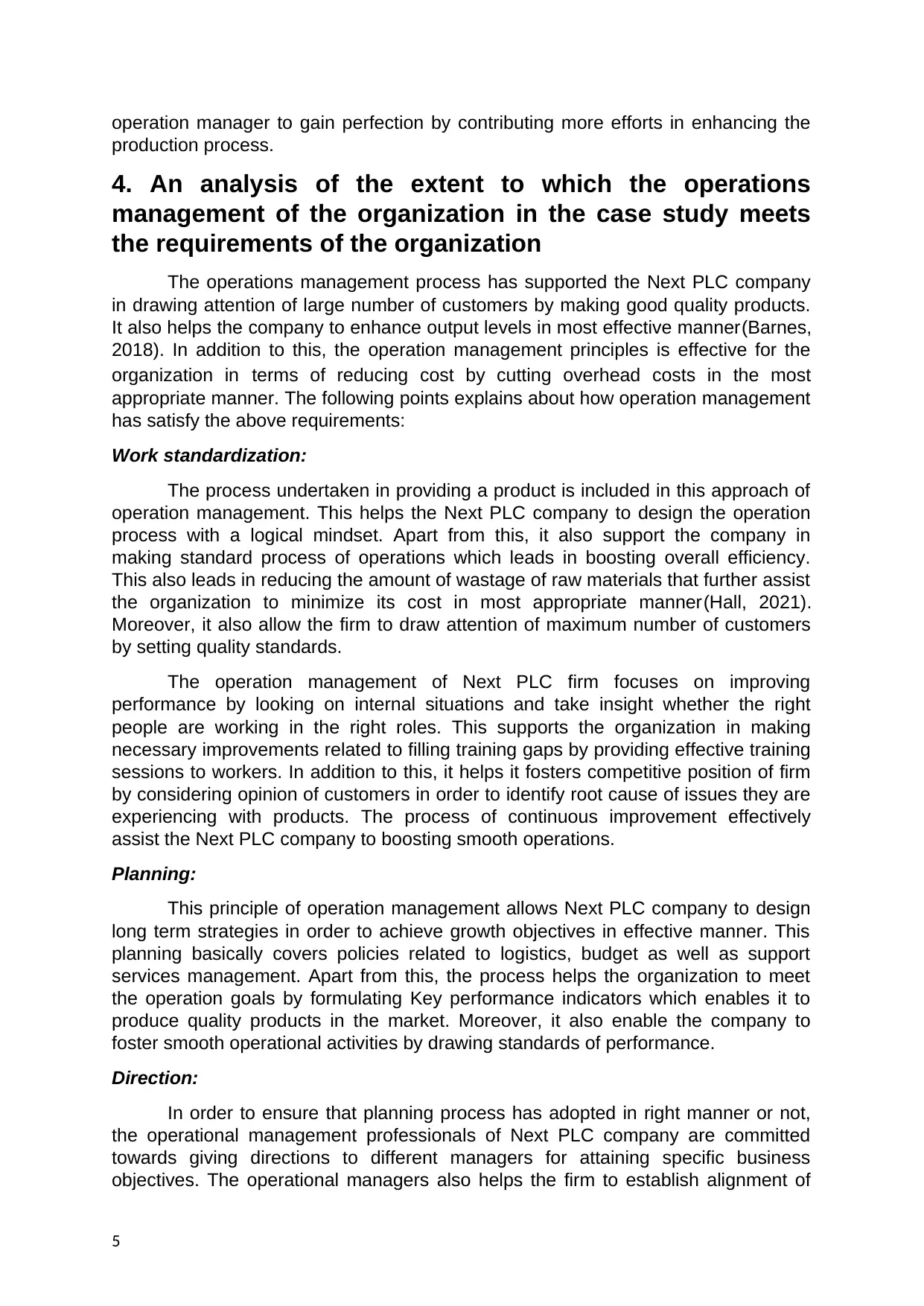
operation manager to gain perfection by contributing more efforts in enhancing the
production process.
4. An analysis of the extent to which the operations
management of the organization in the case study meets
the requirements of the organization
The operations management process has supported the Next PLC company
in drawing attention of large number of customers by making good quality products.
It also helps the company to enhance output levels in most effective manner(Barnes,
2018). In addition to this, the operation management principles is effective for the
organization in terms of reducing cost by cutting overhead costs in the most
appropriate manner. The following points explains about how operation management
has satisfy the above requirements:
Work standardization:
The process undertaken in providing a product is included in this approach of
operation management. This helps the Next PLC company to design the operation
process with a logical mindset. Apart from this, it also support the company in
making standard process of operations which leads in boosting overall efficiency.
This also leads in reducing the amount of wastage of raw materials that further assist
the organization to minimize its cost in most appropriate manner(Hall, 2021).
Moreover, it also allow the firm to draw attention of maximum number of customers
by setting quality standards.
The operation management of Next PLC firm focuses on improving
performance by looking on internal situations and take insight whether the right
people are working in the right roles. This supports the organization in making
necessary improvements related to filling training gaps by providing effective training
sessions to workers. In addition to this, it helps it fosters competitive position of firm
by considering opinion of customers in order to identify root cause of issues they are
experiencing with products. The process of continuous improvement effectively
assist the Next PLC company to boosting smooth operations.
Planning:
This principle of operation management allows Next PLC company to design
long term strategies in order to achieve growth objectives in effective manner. This
planning basically covers policies related to logistics, budget as well as support
services management. Apart from this, the process helps the organization to meet
the operation goals by formulating Key performance indicators which enables it to
produce quality products in the market. Moreover, it also enable the company to
foster smooth operational activities by drawing standards of performance.
Direction:
In order to ensure that planning process has adopted in right manner or not,
the operational management professionals of Next PLC company are committed
towards giving directions to different managers for attaining specific business
objectives. The operational managers also helps the firm to establish alignment of
5
production process.
4. An analysis of the extent to which the operations
management of the organization in the case study meets
the requirements of the organization
The operations management process has supported the Next PLC company
in drawing attention of large number of customers by making good quality products.
It also helps the company to enhance output levels in most effective manner(Barnes,
2018). In addition to this, the operation management principles is effective for the
organization in terms of reducing cost by cutting overhead costs in the most
appropriate manner. The following points explains about how operation management
has satisfy the above requirements:
Work standardization:
The process undertaken in providing a product is included in this approach of
operation management. This helps the Next PLC company to design the operation
process with a logical mindset. Apart from this, it also support the company in
making standard process of operations which leads in boosting overall efficiency.
This also leads in reducing the amount of wastage of raw materials that further assist
the organization to minimize its cost in most appropriate manner(Hall, 2021).
Moreover, it also allow the firm to draw attention of maximum number of customers
by setting quality standards.
The operation management of Next PLC firm focuses on improving
performance by looking on internal situations and take insight whether the right
people are working in the right roles. This supports the organization in making
necessary improvements related to filling training gaps by providing effective training
sessions to workers. In addition to this, it helps it fosters competitive position of firm
by considering opinion of customers in order to identify root cause of issues they are
experiencing with products. The process of continuous improvement effectively
assist the Next PLC company to boosting smooth operations.
Planning:
This principle of operation management allows Next PLC company to design
long term strategies in order to achieve growth objectives in effective manner. This
planning basically covers policies related to logistics, budget as well as support
services management. Apart from this, the process helps the organization to meet
the operation goals by formulating Key performance indicators which enables it to
produce quality products in the market. Moreover, it also enable the company to
foster smooth operational activities by drawing standards of performance.
Direction:
In order to ensure that planning process has adopted in right manner or not,
the operational management professionals of Next PLC company are committed
towards giving directions to different managers for attaining specific business
objectives. The operational managers also helps the firm to establish alignment of
5
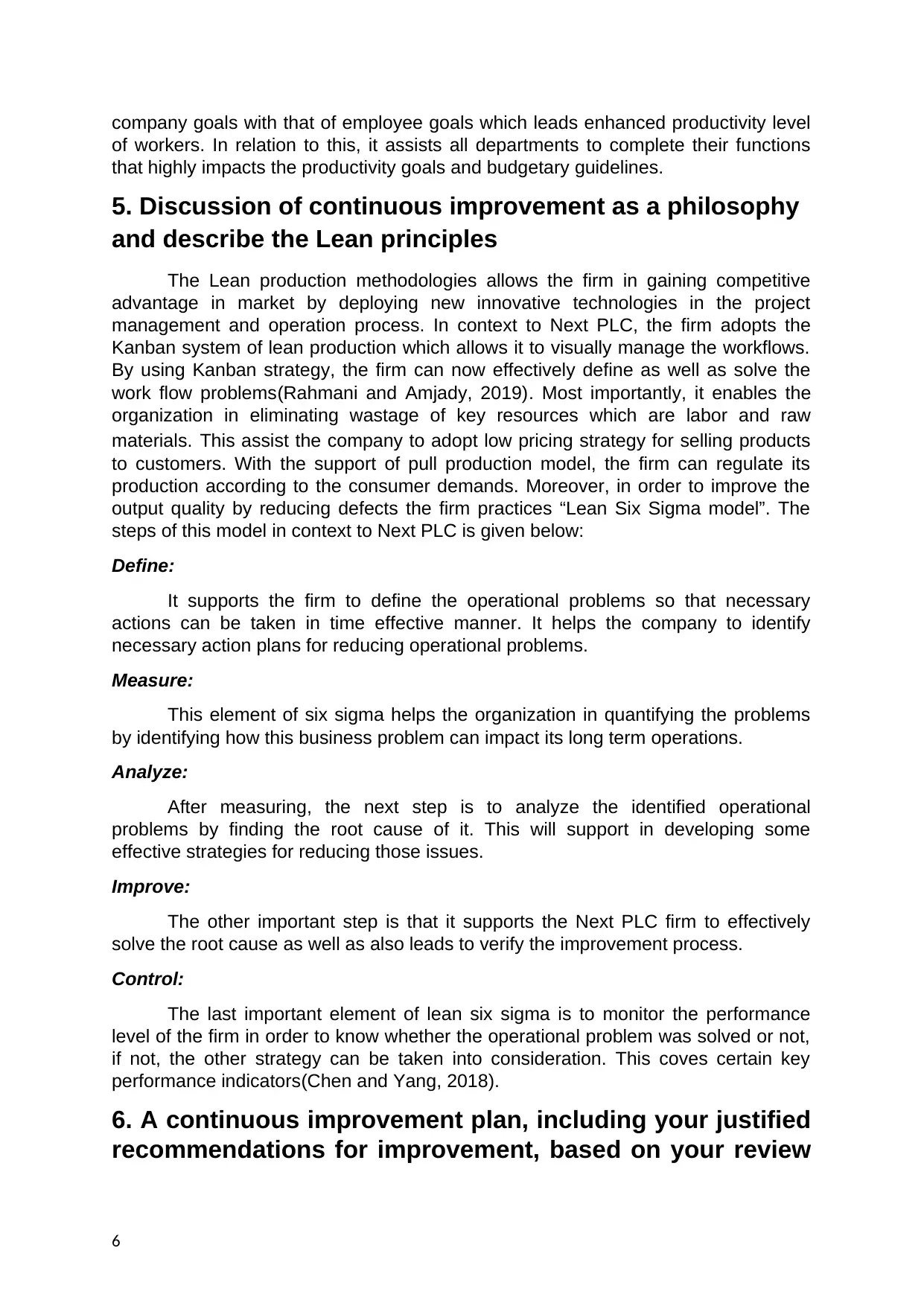
company goals with that of employee goals which leads enhanced productivity level
of workers. In relation to this, it assists all departments to complete their functions
that highly impacts the productivity goals and budgetary guidelines.
5. Discussion of continuous improvement as a philosophy
and describe the Lean principles
The Lean production methodologies allows the firm in gaining competitive
advantage in market by deploying new innovative technologies in the project
management and operation process. In context to Next PLC, the firm adopts the
Kanban system of lean production which allows it to visually manage the workflows.
By using Kanban strategy, the firm can now effectively define as well as solve the
work flow problems(Rahmani and Amjady, 2019). Most importantly, it enables the
organization in eliminating wastage of key resources which are labor and raw
materials. This assist the company to adopt low pricing strategy for selling products
to customers. With the support of pull production model, the firm can regulate its
production according to the consumer demands. Moreover, in order to improve the
output quality by reducing defects the firm practices “Lean Six Sigma model”. The
steps of this model in context to Next PLC is given below:
Define:
It supports the firm to define the operational problems so that necessary
actions can be taken in time effective manner. It helps the company to identify
necessary action plans for reducing operational problems.
Measure:
This element of six sigma helps the organization in quantifying the problems
by identifying how this business problem can impact its long term operations.
Analyze:
After measuring, the next step is to analyze the identified operational
problems by finding the root cause of it. This will support in developing some
effective strategies for reducing those issues.
Improve:
The other important step is that it supports the Next PLC firm to effectively
solve the root cause as well as also leads to verify the improvement process.
Control:
The last important element of lean six sigma is to monitor the performance
level of the firm in order to know whether the operational problem was solved or not,
if not, the other strategy can be taken into consideration. This coves certain key
performance indicators(Chen and Yang, 2018).
6. A continuous improvement plan, including your justified
recommendations for improvement, based on your review
6
of workers. In relation to this, it assists all departments to complete their functions
that highly impacts the productivity goals and budgetary guidelines.
5. Discussion of continuous improvement as a philosophy
and describe the Lean principles
The Lean production methodologies allows the firm in gaining competitive
advantage in market by deploying new innovative technologies in the project
management and operation process. In context to Next PLC, the firm adopts the
Kanban system of lean production which allows it to visually manage the workflows.
By using Kanban strategy, the firm can now effectively define as well as solve the
work flow problems(Rahmani and Amjady, 2019). Most importantly, it enables the
organization in eliminating wastage of key resources which are labor and raw
materials. This assist the company to adopt low pricing strategy for selling products
to customers. With the support of pull production model, the firm can regulate its
production according to the consumer demands. Moreover, in order to improve the
output quality by reducing defects the firm practices “Lean Six Sigma model”. The
steps of this model in context to Next PLC is given below:
Define:
It supports the firm to define the operational problems so that necessary
actions can be taken in time effective manner. It helps the company to identify
necessary action plans for reducing operational problems.
Measure:
This element of six sigma helps the organization in quantifying the problems
by identifying how this business problem can impact its long term operations.
Analyze:
After measuring, the next step is to analyze the identified operational
problems by finding the root cause of it. This will support in developing some
effective strategies for reducing those issues.
Improve:
The other important step is that it supports the Next PLC firm to effectively
solve the root cause as well as also leads to verify the improvement process.
Control:
The last important element of lean six sigma is to monitor the performance
level of the firm in order to know whether the operational problem was solved or not,
if not, the other strategy can be taken into consideration. This coves certain key
performance indicators(Chen and Yang, 2018).
6. A continuous improvement plan, including your justified
recommendations for improvement, based on your review
6
⊘ This is a preview!⊘
Do you want full access?
Subscribe today to unlock all pages.

Trusted by 1+ million students worldwide
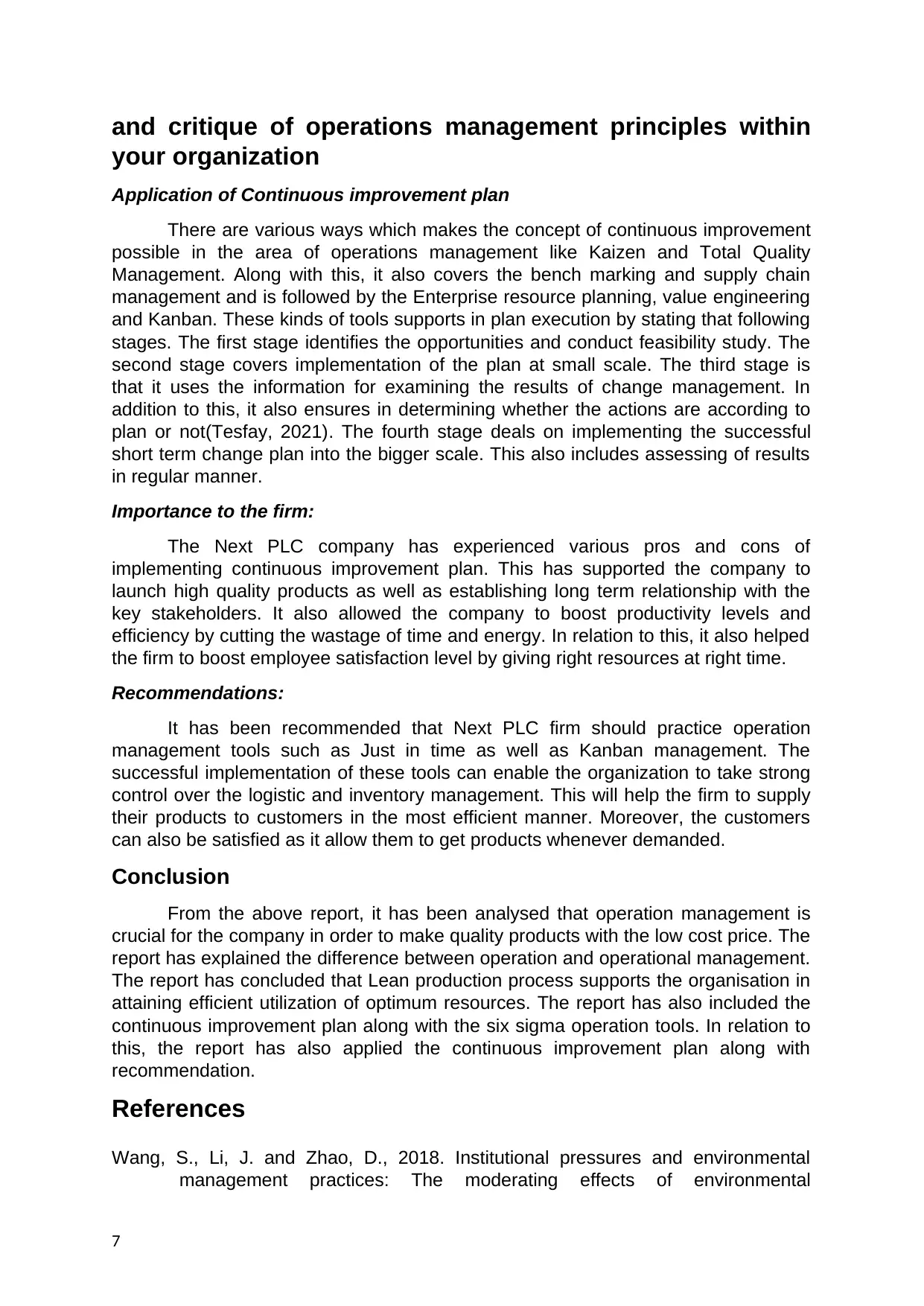
and critique of operations management principles within
your organization
Application of Continuous improvement plan
There are various ways which makes the concept of continuous improvement
possible in the area of operations management like Kaizen and Total Quality
Management. Along with this, it also covers the bench marking and supply chain
management and is followed by the Enterprise resource planning, value engineering
and Kanban. These kinds of tools supports in plan execution by stating that following
stages. The first stage identifies the opportunities and conduct feasibility study. The
second stage covers implementation of the plan at small scale. The third stage is
that it uses the information for examining the results of change management. In
addition to this, it also ensures in determining whether the actions are according to
plan or not(Tesfay, 2021). The fourth stage deals on implementing the successful
short term change plan into the bigger scale. This also includes assessing of results
in regular manner.
Importance to the firm:
The Next PLC company has experienced various pros and cons of
implementing continuous improvement plan. This has supported the company to
launch high quality products as well as establishing long term relationship with the
key stakeholders. It also allowed the company to boost productivity levels and
efficiency by cutting the wastage of time and energy. In relation to this, it also helped
the firm to boost employee satisfaction level by giving right resources at right time.
Recommendations:
It has been recommended that Next PLC firm should practice operation
management tools such as Just in time as well as Kanban management. The
successful implementation of these tools can enable the organization to take strong
control over the logistic and inventory management. This will help the firm to supply
their products to customers in the most efficient manner. Moreover, the customers
can also be satisfied as it allow them to get products whenever demanded.
Conclusion
From the above report, it has been analysed that operation management is
crucial for the company in order to make quality products with the low cost price. The
report has explained the difference between operation and operational management.
The report has concluded that Lean production process supports the organisation in
attaining efficient utilization of optimum resources. The report has also included the
continuous improvement plan along with the six sigma operation tools. In relation to
this, the report has also applied the continuous improvement plan along with
recommendation.
References
Wang, S., Li, J. and Zhao, D., 2018. Institutional pressures and environmental
management practices: The moderating effects of environmental
7
your organization
Application of Continuous improvement plan
There are various ways which makes the concept of continuous improvement
possible in the area of operations management like Kaizen and Total Quality
Management. Along with this, it also covers the bench marking and supply chain
management and is followed by the Enterprise resource planning, value engineering
and Kanban. These kinds of tools supports in plan execution by stating that following
stages. The first stage identifies the opportunities and conduct feasibility study. The
second stage covers implementation of the plan at small scale. The third stage is
that it uses the information for examining the results of change management. In
addition to this, it also ensures in determining whether the actions are according to
plan or not(Tesfay, 2021). The fourth stage deals on implementing the successful
short term change plan into the bigger scale. This also includes assessing of results
in regular manner.
Importance to the firm:
The Next PLC company has experienced various pros and cons of
implementing continuous improvement plan. This has supported the company to
launch high quality products as well as establishing long term relationship with the
key stakeholders. It also allowed the company to boost productivity levels and
efficiency by cutting the wastage of time and energy. In relation to this, it also helped
the firm to boost employee satisfaction level by giving right resources at right time.
Recommendations:
It has been recommended that Next PLC firm should practice operation
management tools such as Just in time as well as Kanban management. The
successful implementation of these tools can enable the organization to take strong
control over the logistic and inventory management. This will help the firm to supply
their products to customers in the most efficient manner. Moreover, the customers
can also be satisfied as it allow them to get products whenever demanded.
Conclusion
From the above report, it has been analysed that operation management is
crucial for the company in order to make quality products with the low cost price. The
report has explained the difference between operation and operational management.
The report has concluded that Lean production process supports the organisation in
attaining efficient utilization of optimum resources. The report has also included the
continuous improvement plan along with the six sigma operation tools. In relation to
this, the report has also applied the continuous improvement plan along with
recommendation.
References
Wang, S., Li, J. and Zhao, D., 2018. Institutional pressures and environmental
management practices: The moderating effects of environmental
7
Paraphrase This Document
Need a fresh take? Get an instant paraphrase of this document with our AI Paraphraser
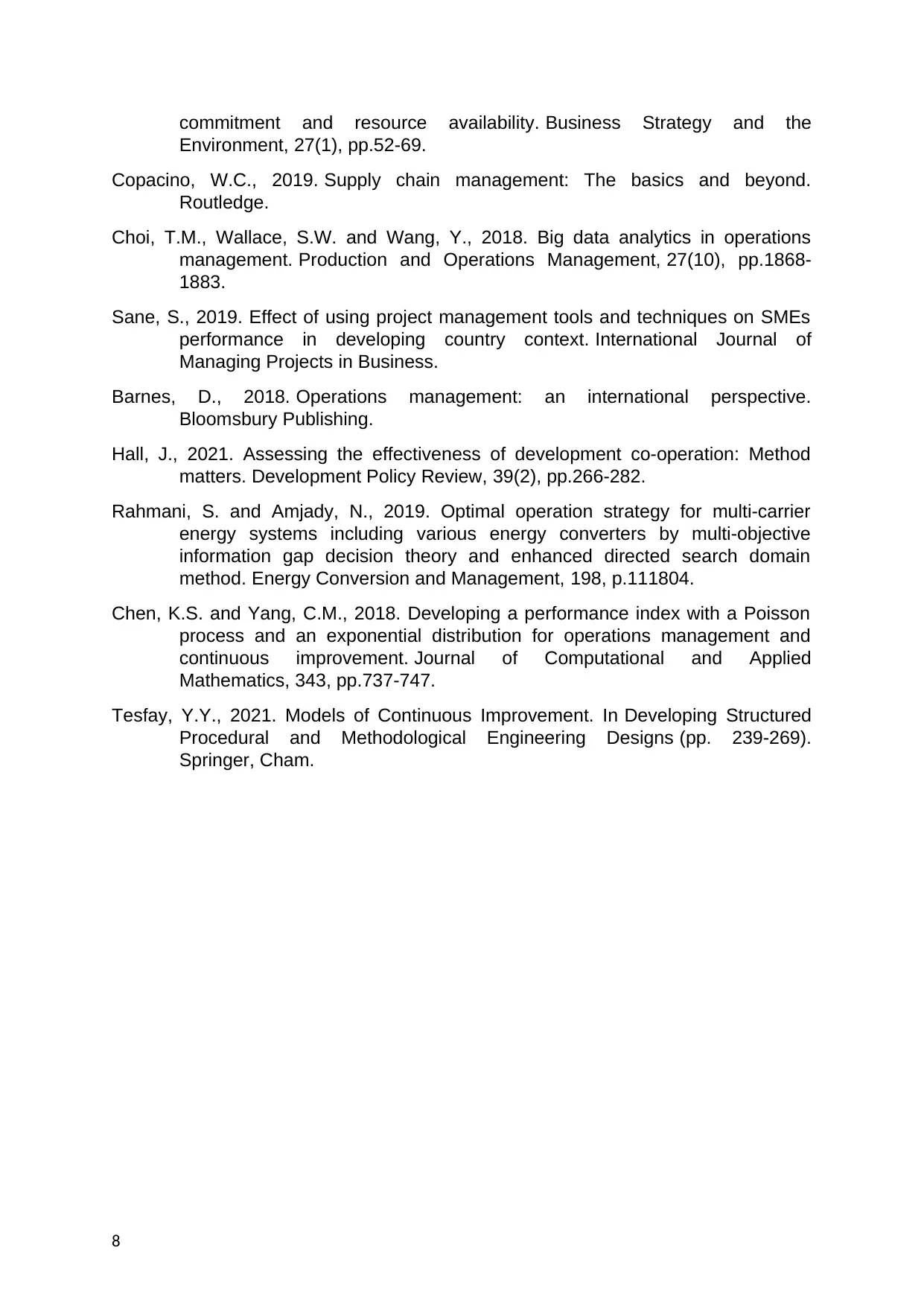
commitment and resource availability. Business Strategy and the
Environment, 27(1), pp.52-69.
Copacino, W.C., 2019. Supply chain management: The basics and beyond.
Routledge.
Choi, T.M., Wallace, S.W. and Wang, Y., 2018. Big data analytics in operations
management. Production and Operations Management, 27(10), pp.1868-
1883.
Sane, S., 2019. Effect of using project management tools and techniques on SMEs
performance in developing country context. International Journal of
Managing Projects in Business.
Barnes, D., 2018. Operations management: an international perspective.
Bloomsbury Publishing.
Hall, J., 2021. Assessing the effectiveness of development co‐operation: Method
matters. Development Policy Review, 39(2), pp.266-282.
Rahmani, S. and Amjady, N., 2019. Optimal operation strategy for multi-carrier
energy systems including various energy converters by multi-objective
information gap decision theory and enhanced directed search domain
method. Energy Conversion and Management, 198, p.111804.
Chen, K.S. and Yang, C.M., 2018. Developing a performance index with a Poisson
process and an exponential distribution for operations management and
continuous improvement. Journal of Computational and Applied
Mathematics, 343, pp.737-747.
Tesfay, Y.Y., 2021. Models of Continuous Improvement. In Developing Structured
Procedural and Methodological Engineering Designs (pp. 239-269).
Springer, Cham.
8
Environment, 27(1), pp.52-69.
Copacino, W.C., 2019. Supply chain management: The basics and beyond.
Routledge.
Choi, T.M., Wallace, S.W. and Wang, Y., 2018. Big data analytics in operations
management. Production and Operations Management, 27(10), pp.1868-
1883.
Sane, S., 2019. Effect of using project management tools and techniques on SMEs
performance in developing country context. International Journal of
Managing Projects in Business.
Barnes, D., 2018. Operations management: an international perspective.
Bloomsbury Publishing.
Hall, J., 2021. Assessing the effectiveness of development co‐operation: Method
matters. Development Policy Review, 39(2), pp.266-282.
Rahmani, S. and Amjady, N., 2019. Optimal operation strategy for multi-carrier
energy systems including various energy converters by multi-objective
information gap decision theory and enhanced directed search domain
method. Energy Conversion and Management, 198, p.111804.
Chen, K.S. and Yang, C.M., 2018. Developing a performance index with a Poisson
process and an exponential distribution for operations management and
continuous improvement. Journal of Computational and Applied
Mathematics, 343, pp.737-747.
Tesfay, Y.Y., 2021. Models of Continuous Improvement. In Developing Structured
Procedural and Methodological Engineering Designs (pp. 239-269).
Springer, Cham.
8
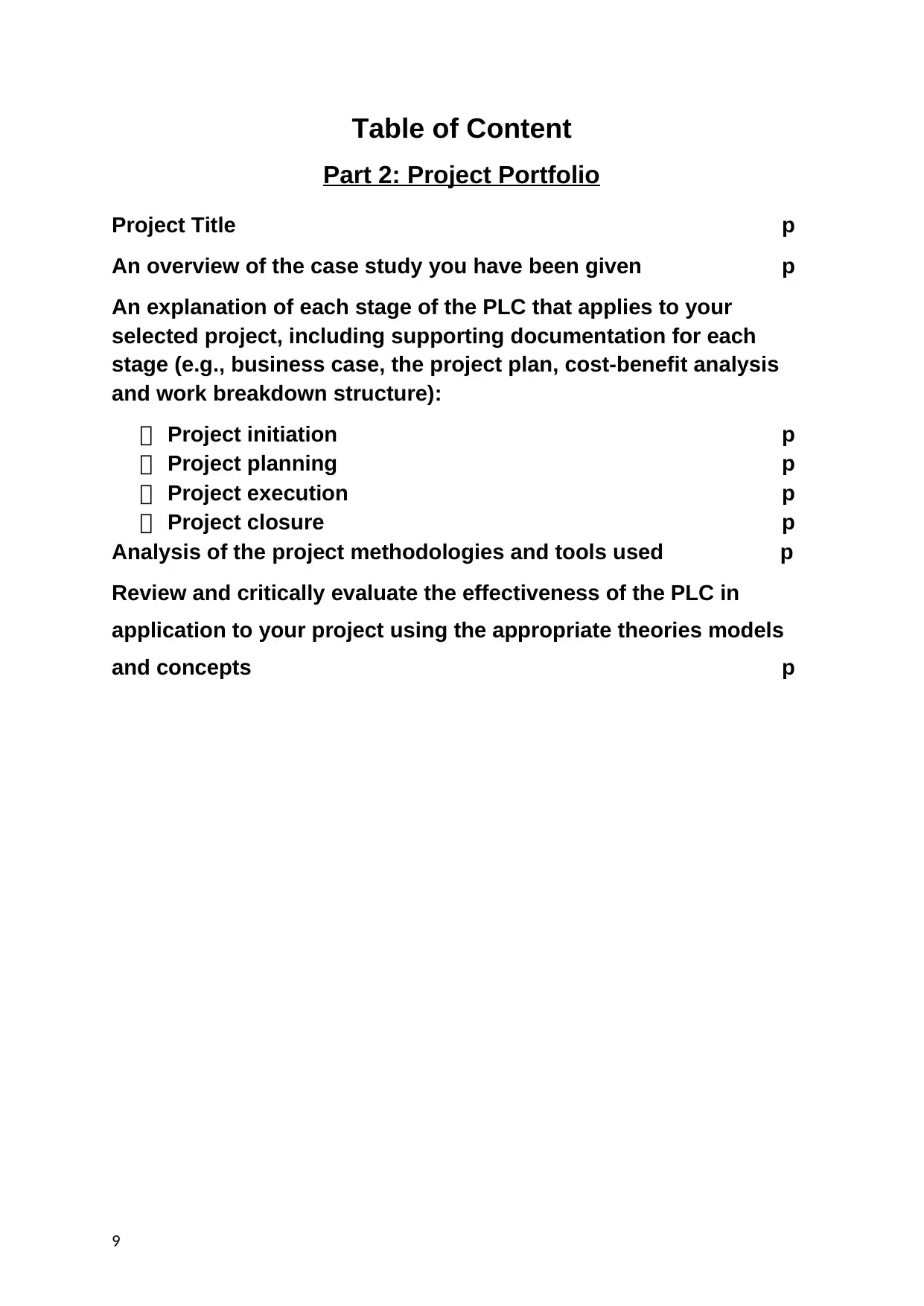
Table of Content
Part 2: Project Portfolio
Project Title p
An overview of the case study you have been given p
An explanation of each stage of the PLC that applies to your
selected project, including supporting documentation for each
stage (e.g., business case, the project plan, cost-benefit analysis
and work breakdown structure):
Project initiation p
Project planning p
Project execution p
Project closure p
Analysis of the project methodologies and tools used p
Review and critically evaluate the effectiveness of the PLC in
application to your project using the appropriate theories models
and concepts p
9
Part 2: Project Portfolio
Project Title p
An overview of the case study you have been given p
An explanation of each stage of the PLC that applies to your
selected project, including supporting documentation for each
stage (e.g., business case, the project plan, cost-benefit analysis
and work breakdown structure):
Project initiation p
Project planning p
Project execution p
Project closure p
Analysis of the project methodologies and tools used p
Review and critically evaluate the effectiveness of the PLC in
application to your project using the appropriate theories models
and concepts p
9
⊘ This is a preview!⊘
Do you want full access?
Subscribe today to unlock all pages.

Trusted by 1+ million students worldwide
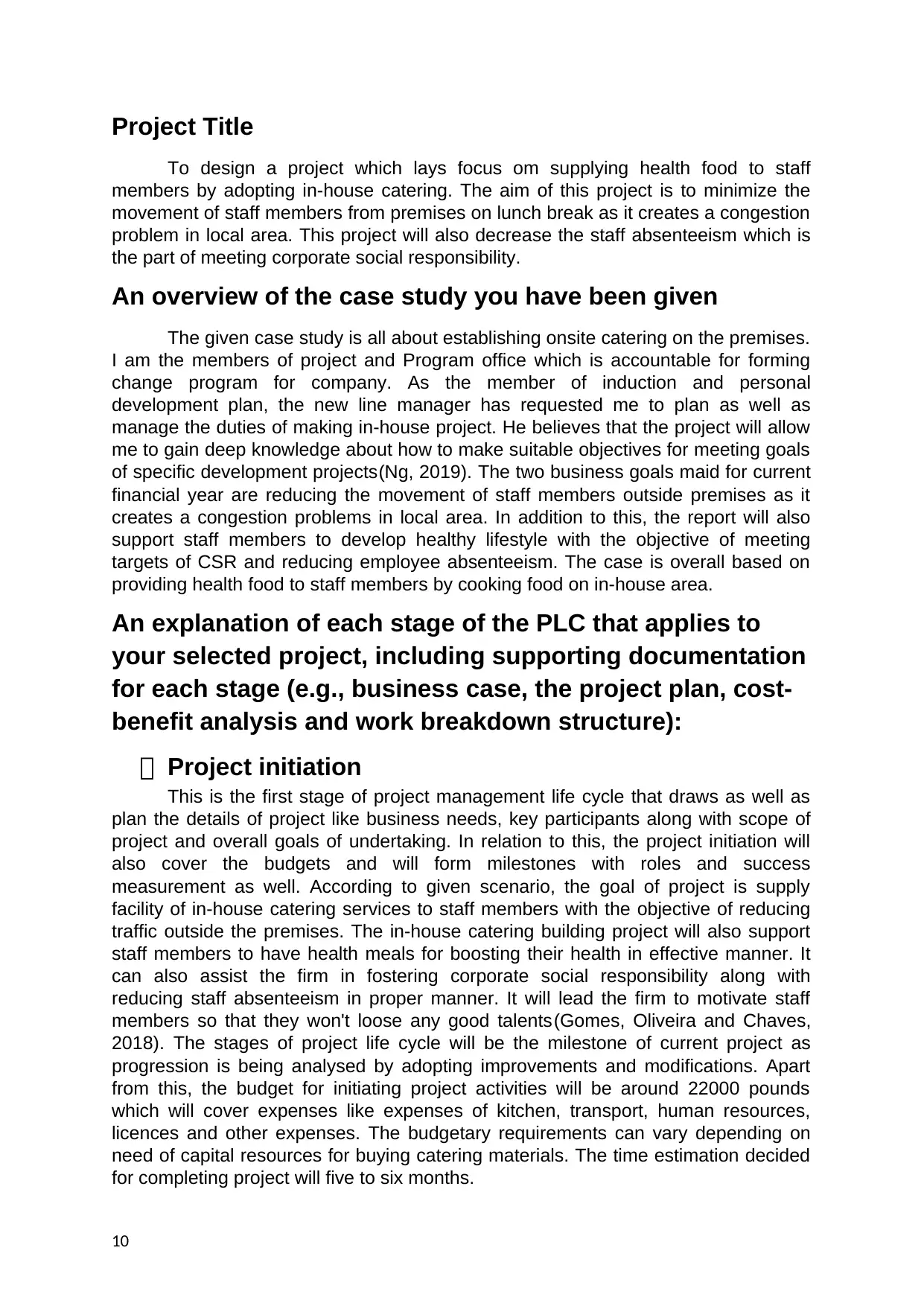
Project Title
To design a project which lays focus om supplying health food to staff
members by adopting in-house catering. The aim of this project is to minimize the
movement of staff members from premises on lunch break as it creates a congestion
problem in local area. This project will also decrease the staff absenteeism which is
the part of meeting corporate social responsibility.
An overview of the case study you have been given
The given case study is all about establishing onsite catering on the premises.
I am the members of project and Program office which is accountable for forming
change program for company. As the member of induction and personal
development plan, the new line manager has requested me to plan as well as
manage the duties of making in-house project. He believes that the project will allow
me to gain deep knowledge about how to make suitable objectives for meeting goals
of specific development projects(Ng, 2019). The two business goals maid for current
financial year are reducing the movement of staff members outside premises as it
creates a congestion problems in local area. In addition to this, the report will also
support staff members to develop healthy lifestyle with the objective of meeting
targets of CSR and reducing employee absenteeism. The case is overall based on
providing health food to staff members by cooking food on in-house area.
An explanation of each stage of the PLC that applies to
your selected project, including supporting documentation
for each stage (e.g., business case, the project plan, cost-
benefit analysis and work breakdown structure):
Project initiation
This is the first stage of project management life cycle that draws as well as
plan the details of project like business needs, key participants along with scope of
project and overall goals of undertaking. In relation to this, the project initiation will
also cover the budgets and will form milestones with roles and success
measurement as well. According to given scenario, the goal of project is supply
facility of in-house catering services to staff members with the objective of reducing
traffic outside the premises. The in-house catering building project will also support
staff members to have health meals for boosting their health in effective manner. It
can also assist the firm in fostering corporate social responsibility along with
reducing staff absenteeism in proper manner. It will lead the firm to motivate staff
members so that they won't loose any good talents(Gomes, Oliveira and Chaves,
2018). The stages of project life cycle will be the milestone of current project as
progression is being analysed by adopting improvements and modifications. Apart
from this, the budget for initiating project activities will be around 22000 pounds
which will cover expenses like expenses of kitchen, transport, human resources,
licences and other expenses. The budgetary requirements can vary depending on
need of capital resources for buying catering materials. The time estimation decided
for completing project will five to six months.
10
To design a project which lays focus om supplying health food to staff
members by adopting in-house catering. The aim of this project is to minimize the
movement of staff members from premises on lunch break as it creates a congestion
problem in local area. This project will also decrease the staff absenteeism which is
the part of meeting corporate social responsibility.
An overview of the case study you have been given
The given case study is all about establishing onsite catering on the premises.
I am the members of project and Program office which is accountable for forming
change program for company. As the member of induction and personal
development plan, the new line manager has requested me to plan as well as
manage the duties of making in-house project. He believes that the project will allow
me to gain deep knowledge about how to make suitable objectives for meeting goals
of specific development projects(Ng, 2019). The two business goals maid for current
financial year are reducing the movement of staff members outside premises as it
creates a congestion problems in local area. In addition to this, the report will also
support staff members to develop healthy lifestyle with the objective of meeting
targets of CSR and reducing employee absenteeism. The case is overall based on
providing health food to staff members by cooking food on in-house area.
An explanation of each stage of the PLC that applies to
your selected project, including supporting documentation
for each stage (e.g., business case, the project plan, cost-
benefit analysis and work breakdown structure):
Project initiation
This is the first stage of project management life cycle that draws as well as
plan the details of project like business needs, key participants along with scope of
project and overall goals of undertaking. In relation to this, the project initiation will
also cover the budgets and will form milestones with roles and success
measurement as well. According to given scenario, the goal of project is supply
facility of in-house catering services to staff members with the objective of reducing
traffic outside the premises. The in-house catering building project will also support
staff members to have health meals for boosting their health in effective manner. It
can also assist the firm in fostering corporate social responsibility along with
reducing staff absenteeism in proper manner. It will lead the firm to motivate staff
members so that they won't loose any good talents(Gomes, Oliveira and Chaves,
2018). The stages of project life cycle will be the milestone of current project as
progression is being analysed by adopting improvements and modifications. Apart
from this, the budget for initiating project activities will be around 22000 pounds
which will cover expenses like expenses of kitchen, transport, human resources,
licences and other expenses. The budgetary requirements can vary depending on
need of capital resources for buying catering materials. The time estimation decided
for completing project will five to six months.
10
Paraphrase This Document
Need a fresh take? Get an instant paraphrase of this document with our AI Paraphraser
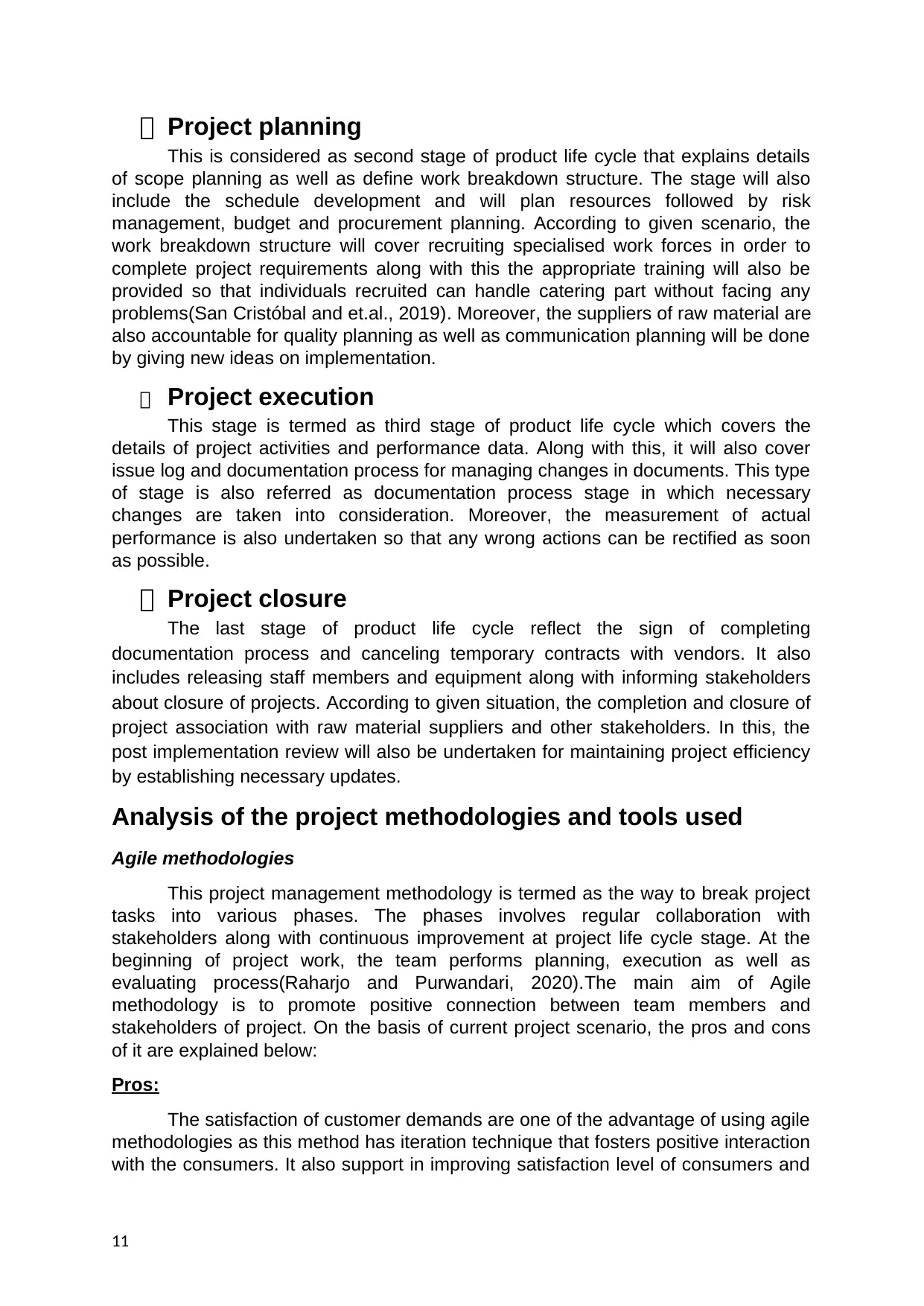
Project planning
This is considered as second stage of product life cycle that explains details
of scope planning as well as define work breakdown structure. The stage will also
include the schedule development and will plan resources followed by risk
management, budget and procurement planning. According to given scenario, the
work breakdown structure will cover recruiting specialised work forces in order to
complete project requirements along with this the appropriate training will also be
provided so that individuals recruited can handle catering part without facing any
problems(San Cristóbal and et.al., 2019). Moreover, the suppliers of raw material are
also accountable for quality planning as well as communication planning will be done
by giving new ideas on implementation.
Project execution
This stage is termed as third stage of product life cycle which covers the
details of project activities and performance data. Along with this, it will also cover
issue log and documentation process for managing changes in documents. This type
of stage is also referred as documentation process stage in which necessary
changes are taken into consideration. Moreover, the measurement of actual
performance is also undertaken so that any wrong actions can be rectified as soon
as possible.
Project closure
The last stage of product life cycle reflect the sign of completing
documentation process and canceling temporary contracts with vendors. It also
includes releasing staff members and equipment along with informing stakeholders
about closure of projects. According to given situation, the completion and closure of
project association with raw material suppliers and other stakeholders. In this, the
post implementation review will also be undertaken for maintaining project efficiency
by establishing necessary updates.
Analysis of the project methodologies and tools used
Agile methodologies
This project management methodology is termed as the way to break project
tasks into various phases. The phases involves regular collaboration with
stakeholders along with continuous improvement at project life cycle stage. At the
beginning of project work, the team performs planning, execution as well as
evaluating process(Raharjo and Purwandari, 2020).The main aim of Agile
methodology is to promote positive connection between team members and
stakeholders of project. On the basis of current project scenario, the pros and cons
of it are explained below:
Pros:
The satisfaction of customer demands are one of the advantage of using agile
methodologies as this method has iteration technique that fosters positive interaction
with the consumers. It also support in improving satisfaction level of consumers and
11
This is considered as second stage of product life cycle that explains details
of scope planning as well as define work breakdown structure. The stage will also
include the schedule development and will plan resources followed by risk
management, budget and procurement planning. According to given scenario, the
work breakdown structure will cover recruiting specialised work forces in order to
complete project requirements along with this the appropriate training will also be
provided so that individuals recruited can handle catering part without facing any
problems(San Cristóbal and et.al., 2019). Moreover, the suppliers of raw material are
also accountable for quality planning as well as communication planning will be done
by giving new ideas on implementation.
Project execution
This stage is termed as third stage of product life cycle which covers the
details of project activities and performance data. Along with this, it will also cover
issue log and documentation process for managing changes in documents. This type
of stage is also referred as documentation process stage in which necessary
changes are taken into consideration. Moreover, the measurement of actual
performance is also undertaken so that any wrong actions can be rectified as soon
as possible.
Project closure
The last stage of product life cycle reflect the sign of completing
documentation process and canceling temporary contracts with vendors. It also
includes releasing staff members and equipment along with informing stakeholders
about closure of projects. According to given situation, the completion and closure of
project association with raw material suppliers and other stakeholders. In this, the
post implementation review will also be undertaken for maintaining project efficiency
by establishing necessary updates.
Analysis of the project methodologies and tools used
Agile methodologies
This project management methodology is termed as the way to break project
tasks into various phases. The phases involves regular collaboration with
stakeholders along with continuous improvement at project life cycle stage. At the
beginning of project work, the team performs planning, execution as well as
evaluating process(Raharjo and Purwandari, 2020).The main aim of Agile
methodology is to promote positive connection between team members and
stakeholders of project. On the basis of current project scenario, the pros and cons
of it are explained below:
Pros:
The satisfaction of customer demands are one of the advantage of using agile
methodologies as this method has iteration technique that fosters positive interaction
with the consumers. It also support in improving satisfaction level of consumers and
11
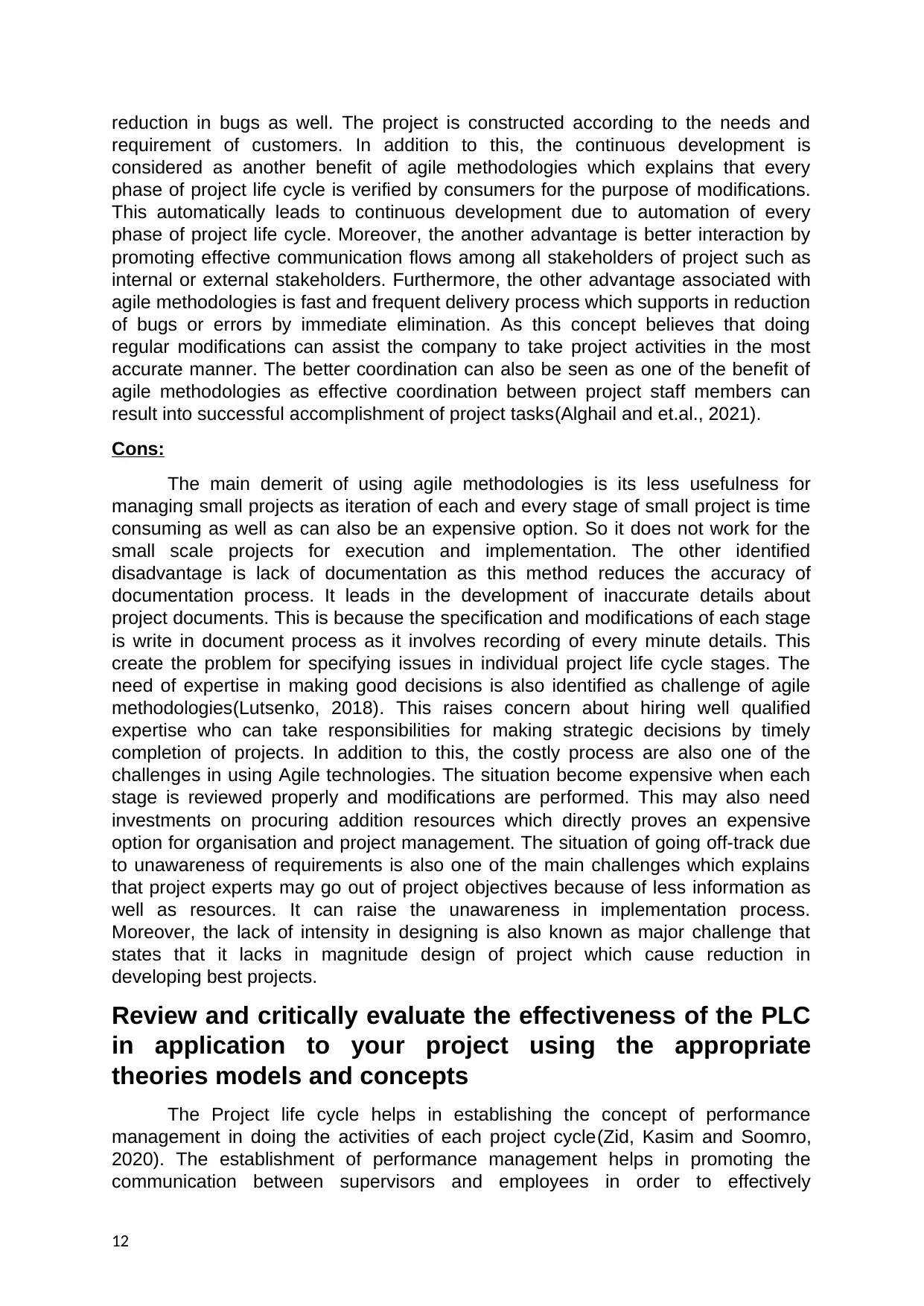
reduction in bugs as well. The project is constructed according to the needs and
requirement of customers. In addition to this, the continuous development is
considered as another benefit of agile methodologies which explains that every
phase of project life cycle is verified by consumers for the purpose of modifications.
This automatically leads to continuous development due to automation of every
phase of project life cycle. Moreover, the another advantage is better interaction by
promoting effective communication flows among all stakeholders of project such as
internal or external stakeholders. Furthermore, the other advantage associated with
agile methodologies is fast and frequent delivery process which supports in reduction
of bugs or errors by immediate elimination. As this concept believes that doing
regular modifications can assist the company to take project activities in the most
accurate manner. The better coordination can also be seen as one of the benefit of
agile methodologies as effective coordination between project staff members can
result into successful accomplishment of project tasks(Alghail and et.al., 2021).
Cons:
The main demerit of using agile methodologies is its less usefulness for
managing small projects as iteration of each and every stage of small project is time
consuming as well as can also be an expensive option. So it does not work for the
small scale projects for execution and implementation. The other identified
disadvantage is lack of documentation as this method reduces the accuracy of
documentation process. It leads in the development of inaccurate details about
project documents. This is because the specification and modifications of each stage
is write in document process as it involves recording of every minute details. This
create the problem for specifying issues in individual project life cycle stages. The
need of expertise in making good decisions is also identified as challenge of agile
methodologies(Lutsenko, 2018). This raises concern about hiring well qualified
expertise who can take responsibilities for making strategic decisions by timely
completion of projects. In addition to this, the costly process are also one of the
challenges in using Agile technologies. The situation become expensive when each
stage is reviewed properly and modifications are performed. This may also need
investments on procuring addition resources which directly proves an expensive
option for organisation and project management. The situation of going off-track due
to unawareness of requirements is also one of the main challenges which explains
that project experts may go out of project objectives because of less information as
well as resources. It can raise the unawareness in implementation process.
Moreover, the lack of intensity in designing is also known as major challenge that
states that it lacks in magnitude design of project which cause reduction in
developing best projects.
Review and critically evaluate the effectiveness of the PLC
in application to your project using the appropriate
theories models and concepts
The Project life cycle helps in establishing the concept of performance
management in doing the activities of each project cycle(Zid, Kasim and Soomro,
2020). The establishment of performance management helps in promoting the
communication between supervisors and employees in order to effectively
12
requirement of customers. In addition to this, the continuous development is
considered as another benefit of agile methodologies which explains that every
phase of project life cycle is verified by consumers for the purpose of modifications.
This automatically leads to continuous development due to automation of every
phase of project life cycle. Moreover, the another advantage is better interaction by
promoting effective communication flows among all stakeholders of project such as
internal or external stakeholders. Furthermore, the other advantage associated with
agile methodologies is fast and frequent delivery process which supports in reduction
of bugs or errors by immediate elimination. As this concept believes that doing
regular modifications can assist the company to take project activities in the most
accurate manner. The better coordination can also be seen as one of the benefit of
agile methodologies as effective coordination between project staff members can
result into successful accomplishment of project tasks(Alghail and et.al., 2021).
Cons:
The main demerit of using agile methodologies is its less usefulness for
managing small projects as iteration of each and every stage of small project is time
consuming as well as can also be an expensive option. So it does not work for the
small scale projects for execution and implementation. The other identified
disadvantage is lack of documentation as this method reduces the accuracy of
documentation process. It leads in the development of inaccurate details about
project documents. This is because the specification and modifications of each stage
is write in document process as it involves recording of every minute details. This
create the problem for specifying issues in individual project life cycle stages. The
need of expertise in making good decisions is also identified as challenge of agile
methodologies(Lutsenko, 2018). This raises concern about hiring well qualified
expertise who can take responsibilities for making strategic decisions by timely
completion of projects. In addition to this, the costly process are also one of the
challenges in using Agile technologies. The situation become expensive when each
stage is reviewed properly and modifications are performed. This may also need
investments on procuring addition resources which directly proves an expensive
option for organisation and project management. The situation of going off-track due
to unawareness of requirements is also one of the main challenges which explains
that project experts may go out of project objectives because of less information as
well as resources. It can raise the unawareness in implementation process.
Moreover, the lack of intensity in designing is also known as major challenge that
states that it lacks in magnitude design of project which cause reduction in
developing best projects.
Review and critically evaluate the effectiveness of the PLC
in application to your project using the appropriate
theories models and concepts
The Project life cycle helps in establishing the concept of performance
management in doing the activities of each project cycle(Zid, Kasim and Soomro,
2020). The establishment of performance management helps in promoting the
communication between supervisors and employees in order to effectively
12
⊘ This is a preview!⊘
Do you want full access?
Subscribe today to unlock all pages.

Trusted by 1+ million students worldwide
1 out of 17
Related Documents
Your All-in-One AI-Powered Toolkit for Academic Success.
+13062052269
info@desklib.com
Available 24*7 on WhatsApp / Email
![[object Object]](/_next/static/media/star-bottom.7253800d.svg)
Unlock your academic potential
Copyright © 2020–2025 A2Z Services. All Rights Reserved. Developed and managed by ZUCOL.


